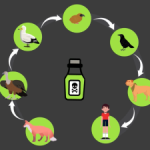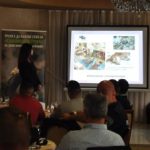From 14th-17th of November in Cáceres, the international conference on vultures in Europe took place in which two representatives from our organization participated. Throughout history, four subspecies of vultures are consistently inhabiting Europe: the Griffon vulture (Gyps fulvus), the Egyptian vulture (Neophron percnopterus), the Black vulture (Aegypius monachus) and the Bearded vulture (Gypaetus barbatus). In recent years, it is assumed that with climate changes and favorable conditions for life on the Apennine peninsula, Rupelle’s vulture (Gyps rueppelli) has recently settled on the continent as well.
The conference, which was organized by the Vulture Conservation Foundation, had a rich program with about 200 presentations, with more than 400 participants from 45 countries. The presentations and topics related to vultures were diverse and clearly and accurately reflected the situation of vultures only in Europe but across the world.

The keynote speakers were leading scientists in the field of nature conservation and vulture research including Sergio Lambertucci, Pascual López López, Darcy Ogada, Marcos Moleon Paiz and many others.
Research shared throughout the event was on a variety of topics:
- Various poisoning threats (through the use of lead bullets, diclofenac as an antibiotic for livestock, intentional and unintentional poisoning of vultures through the placement of poisonous baits in nature)
- The need for proper insulation of transmission poles to prevent electrocution and/or bird strikes
- The need for informed placement of wind turbines in order to avoid collisions with birds
- Necessary cooperation with rural communities when dealing with human-wildlife conflicts in order to prevent deteriorating relations
- Bearded vulture breeding methods and centers
- Programs and methods for re-introduction of vultures back into the wild
- Emphasis was also placed on the availability of food for vultures
- The Balkans were mentioned as the most important and key part in the protection and connection of the different populations of vultures in Europe. In order to establish a good and stable population of vultures in Europe, it is necessary to increase and speed up the measures for the conservation and reintroduction of all four species of vultures in the Balkans.
In addition, the conference presented activities carried out within the regional project BalkanDetox LIFE, which the MES is co-beneficiary of and focuses on strengthening state capacities by preventing and dealing with cases of poisoning of wild animals. Although some of the problems are similar around the world when it comes to threats to vultures, the number and development of populations is relative depending on the states capacity and desire to work towards the protection of this species. Vultures are recognized as crucial to many ecosystems in that they can quickly, efficiently, and thoroughly dispose of dead animals and thereby prevent the spread of infectious diseases.
It was not a coincidence that Cáceres was chosen as the location for this conference as it is a site that currently supports the largest population of Griffon and Black vultures in Europe. During the conference, participants observed several flocks of 10 birds circling over the small medieval town. Excursions were organized to the Montfrague National Park as well as the fields and meadows around Cáceres. These were extraordinary opportunities to see how here people and wildlife live hand in hand and care for a healthy and sustainable ecosystem.



